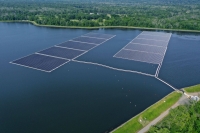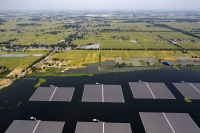Solar power is expected to dominate global electricity markets in the next few decades, and already accounts for three-quarters of renewable energy capacity, according to the International Energy Agency. This year, BloombergNEF predicts solar builds will climb another 25%, adding more than 500 gigawatts of capacity.
All of that solar needs a lot of space. Powering just one megawatt of capacity requires at least five acres, meaning a 200-MW project (roughly 3,000 panels) takes up as much space as 550 American football fields. That calculus is one reason China — the world’s biggest solar market — is hosting many projects in remote desert regions. It’s also why the IEA expects rooftop and residential solar to expand faster than farms this year.
"It’s great to have (solar installations) in our communities,” says Bonnie Heiple, commissioner at the Massachusetts Department of Energy. "Actually seeing where your power comes from gives people more of an impetus to make the types of changes in their daily lives we’re asking them to make.”
As solar gains momentum, its champions are getting more creative about where to place panels. There are solar arrays on top of big-box stores, solar arrays on yachts and solar farms that float. There are panels small enough to work on a balcony and even small enough to attach to a smartphone. To minimize clearing land, engineers are also working on incorporating the technology into existing infrastructure. From landfills to art installations, here are five unexpected places you can find a solar farm — or at least some strategically placed panels.
Carports
Parking lots and garages require plenty of space. Adding a solar canopy can provide shade, safety and seamless charging for EVs, says Ben Jones, vice president of design and engineering at New York-based DSD Renewables. DSD is behind a project to add solar canopies to 16 parking lots and garages at Rutgers University in New Jersey and has installed almost 200 MW of canopy projects across the U.S. since it was founded in 2019.
It’s also the architect of a 6.5-MW canopy project at Caesars Entertainment Casinos in Atlantic City, New Jersey. The project supplies about 6% of the energy used by the casino, while also providing shade for the top deck of the parking garage.
Jones says canopy projects use land efficiently and can also meaningfully contribute to a company or municipality’s renewable energy goals. "It’s quite a statement that blends in nicely, but also lowers their operating expenses,” he says.
(Retired) golf courses
Shuttered golf courses can be ideal locations for solar farms. There’s less work required to clear the land, and the terrain tends to be relatively flat. There’s also some poetic justice to installing renewable energy at places that used to eat up water resources and compromise local biodiversity.
In Calverton, Long Island, the Calverton Links Golf Course is home to a nearly 23-MW solar project that opened in 2022, nine years after the course closed for business. The project is owned by National Grid Ventures, the venture capital arm of National Grid, which operates power grids in the U.K. and U.S. Will Hazelip, president of National Grid Ventures Northeast, says the keys to finding a golf course that’s ideal for solar are a reasonable price tag and proximity to grid infrastructure.
"You're close to the demand and it’s a large amount of space,” he says. "The challenge is finding that exact combination.”
Floating solar farms
To dodge land constraints entirely, many countries are experimenting with solar farms that float. While the costs can be high — 40% more than land farms, according to BloombergNEF — big flat surfaces with constant access to sunlight are compelling.
Hundreds of floating projects have been erected on lakes and reservoirs around the world. Japan has dozens of smaller floating arrays, India has added major operations, and facilities have been built in countries that include Colombia, Israel and Ghana. Last year, the largest floating solar project in the U.S. went online in New Jersey, where it generates enough energy to power 1,400 homes.
In China, a massive floating solar farm in Huainan in the eastern Anhui province boasts more than 500,000 panels — enough to generate power for over 100,000 homes. The flotilla of panels is the size of 400 soccer pitches and stretches across an artificial lake that sits on top of a former coal mine (more poetic justice).
Floating farms don’t necessarily generate more electricity than those on land, but a study published in Nature Sustainability found that more than 6,000 local power systems around the world could be entirely self-sufficient with floating farms.
Landfills and decommissioned fossil fuel sites
As climate change drives a shift from fossil fuels to renewable energy, there are a growing number of opportunities to realize that shift directly: Decommissioned fossil fuel sites, which already have access to local power grids, are excellent candidates for solar farms, says Thomas Byrne, chief executive officer of New York-based renewables company CleanCapital.
"What a wonderful story it is to be able to say, ‘Everyone disregarded this piece of land, but now we’re utilizing it again to power the future,’” Byrne says. CleanCapital owns and operates 300 MW of solar capacity, including a solar farm on a former steel plant in Buffalo, New York.
In the U.S., the Inflation Reduction Act passed in 2022 includes incentives for companies to build solar projects on brownfields — landfills and decommissioned industrial plants whose opportunities for reuse are otherwise severely limited. Last year, the U.S. Environmental Protection Agency introduced a program to promote and assist these kinds of transformations.
"It’s dead space and can’t be built on otherwise, you might as well build a solar farm,” says Jones at DSD, which opened a 4.3-MW solar farm on a landfill last year in Bethel, New York. More than half of the power generated supplies local residents and businesses.
Massachusetts, which offers its own tax incentives for developers to install solar on brownfields, currently leads the U.S. in such installations; the state has 92 solar farms on closed landfills, totaling 256 MW of capacity. In 2022, the solar landfills offset more than 62,000 tons of carbon dioxide emissions, according to the Massachusetts Department of Energy.
Solar art
Artist Elizabeth Monoian and architect Robert Ferry are the husband-and-wife duo behind Land Art Generator, an organization that holds competitions for solar art designers and connects the winners to communities that provide public art grants. Started in 2008, Land Art Generator now has more than 1,500 artist ideas it shops to communities around the world.
In San Antonio, Land Art Generator worked with JT Brackenridge Elementary School to create a solar-panel mural that celebrates the community’s history. The art printed on the panels — a photo of the class of 1906 and the fifth-grade class of 2020 — only shaves off 4% of the energy it would have generated otherwise.
Next year, Land Art Generator plans to unveil the 30-meter-tall "Arch of Time” in a Houston park. Designed by Berlin-based artist and architect Riccardo Mariano, the project is made from black solar panels and will provide shade while generating enough energy to power 40 nearby homes. The installation also acts as a clock, projecting the sun’s rays in alternating colors.
"We’re at a point where solar is the least expensive way to make energy ... no matter how you slice it, no matter where you are,” Ferry says. "There has become a breathing space for the industry to explore new ways of designing these infrastructures.”




















With your current subscription plan you can comment on stories. However, before writing your first comment, please create a display name in the Profile section of your subscriber account page.